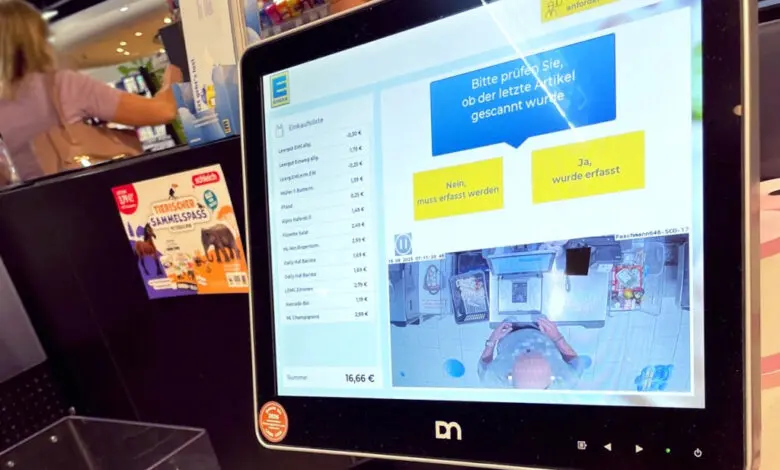Less stress, more help: How AI self-checkout benefits retail employees
14th March 2025

The self-checkout experience: Why getting it right matters
As shoppers, we like to navigate our grocery stores independently, selecting the items we need before heading to checkout. And it’s at checkout where we are most likely to meet or need to call upon store teams for assistance. Which is why getting the checkout experience right is so critical. It’s also the last point in the store journey for a retailer to deliver on their customer promise of a fast, seamless shopping experience.
But, here’s the challenge. At self-checkout when an item won’t scan or a scale fails to register an item, delayed support from employees can lead customers to frustration fraud (walking out without paying), or worse, conflict. Imagine turning that situation on its head enabling shoppers to self-correct common mistakes, which has been proven to happen 80% of the time, while reducing the need for staff intervention by up to 15%.
This blog explores how AI-powered self-checkouts are delivering these benefits for retailers and their employees, now. From improving efficiency and reducing staff stress to creating a more positive in-store environment.
Reducing employee pressure with AI-powered self-checkouts
The pressure on retail employees
Managing checkout issues is just one of the many pressures retail employees face. Customer frustration plays a significant role, especially when shoppers experience delays or confusion at self-checkout. Employees often become the bridge to diffusing tension, which increases their stress and risk of conflict.
Retailers are contending with persistent staffing shortages, despite increasingly competitive pay and benefits – the UK has around 79,000 retail vacancies, while the US faces over 550,000 unfilled positions. This means current frontline retail employees are often left to manage increased workloads with limited support.
The impact of customer frustration
Stores which have first-generation self-checkouts often have employees rushing from one customer to another, trying to resolve issues and minimize disruption. The longer customers wait, the greater the risk of frustration escalating into conflict. In fact, an ECR loss report found a direct correlation between the number of self-checkouts supervised by an employee and the frequency of violent incidents. This constant pressure, combined with rising abuse and violence, is driving employees away.
According to the British Retail Consortium’s 2025 survey, UK retail employees now face over 2,000 incidents of violence and abuse every day – up from 1,300 incidents in 2024. Unsurprisingly, 39% of retail workers have considered quitting their roles or leaving the industry altogether.
The role of AI-powered self-checkouts in reducing stress
AI-powered self-checkouts provide much needed relief by allowing customers to self-correct mistakes, something 80% will do when nudged, and reducing unnecessary interventions. Employees are freed to focus on genuine support where it’s needed – without feeling like they’re accusing honest customers or being drawn into conflict.
Evidence videos delivered on handheld devices, for example, allow employees to assess a situation from a distance, stepping in when appropriate or escalating concerns to security when necessary. This helps staff stay in control, provide better service and feel safer in their roles.
By easing workloads and minimizing stressful interactions, AI-powered self-checkouts also create opportunities for employee development. Staff can take on roles such as self-checkout coaches, guiding customers, encouraging self-checkout adoption, and building new skills. This shift not only improves job satisfaction but also helps employees feel more valued and purposeful in their roles.
Case study: The benefits of self-checkouts in reducing employee interventions
While AI was initially introduced to reduce losses at self-checkout, deployments have shown that next-generation systems bring additional advantages.
For example, Intermarché, France’s third-largest retailer, piloted computer vision AI at self-checkouts in its La Farlède store, helping customers correct mistakes without employee intervention. The results were striking:
- shrink levels at shelf-checkout dropped from 3% to below 1%
- employee interventions fell by nearly 15%, saving 3,000 interventions in just two months.
Employees welcomed the change, with one noting, “Before, staff at checkouts were as much cashiers as security agents; now, they can be more involved in helping and engaging with customers.”
AI-powered self-checkouts: Simplifying the checkout process
AI-powered self-checkouts not only improve operational efficiency they also help to reduce employee stress. By decreasing customer interventions by up to 15%, employees can focus on other crucial parts of their roles, improving job satisfaction and performance.
For example, fresh produce and AI-powered non-barcoded item recognition further simplifies the checkout process by:
- Enabling 4X faster transactions, and boosting transactions per hour by up to 40%
- Eliminating the need for customers to search on-screen menus – something The Grocer reported 10% of regular self-checkout users saw as an influencing factor when deciding to use a self-checkout
- Unifying approaches store-wide to non-barcoded items enabling customers to use the same technology in aisles or at checkout
For employees, these benefits lead to fewer disruptions at self-checkout as customers can easily identify produce items, resulting in less frustration and creating a happier, more relaxed work environment.
Learn more about how AI advancements are transforming self-checkouts in our self-checkout security guide.
Creating a better retail workplace with AI-powered self-checkouts
With the computer vision market projected to reach $386 billion by 2031, retail stands out as a key player in this transformative growth. As AI adoption expands, the benefits of self-checkouts for both operational efficiency and employee satisfaction become increasingly clear, as has been seen in the case of the self-checkout.
Retailers investing in AI-powered solutions are seeing real results, not just in reducing shrink and improving the shopper experience, but in creating a more sustainable work environment for employees. The key lies in operationalizing AI effectively, ensuring it reduces stress rather than increasing workloads. With valuable improvements at self-checkout, such as minimizing unnecessary interventions, reducing customer frustration, and enabling staff to focus on high-value interactions, computer vision AI becomes a strategic tool for improving employee retention.
At a time when recruitment is a challenge and in-store aggression is on the rise, computer vision AI is not just optimizing operations—it’s making retail a better place to work.



